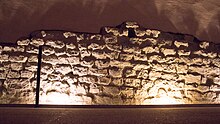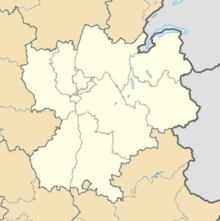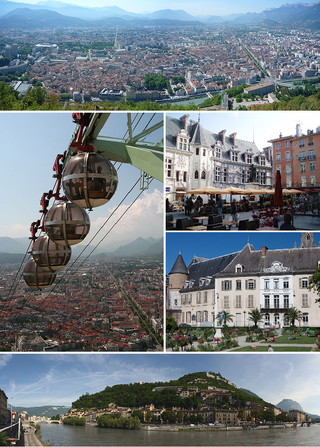
Grenoble is the prefecture and largest city of the Isère department in the Auvergne-Rhône-Alpes region of southeastern France. It was the capital of the Dauphiné historical province and lies where the river Drac flows into the Isère at the foot of the French Alps.

Durocortorum was the name of the city Reims during the Roman era. It was the capital of the Remi tribe and the second largest city in Roman Gaul.
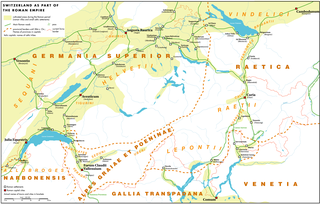
Aventicum was the largest town and capital of Roman Switzerland. Its remains are beside the modern town of Avenches.

Cularo was the name of the Gallic city which evolved into modern Grenoble. It was renamed Gratianopolis in 381 to honor Roman emperor Gratian.

Vizille is a commune in the Isère department in southeastern France.

Saint-Quentin-Fallavier is a commune in the Isère department, and the Auvergne-Rhône-Alpes region, in southeastern France.
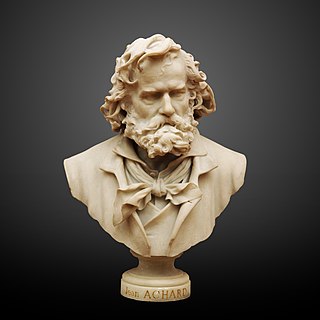
Jean Alexis Achard was a French painter.

Jacques Gay was a French painter.
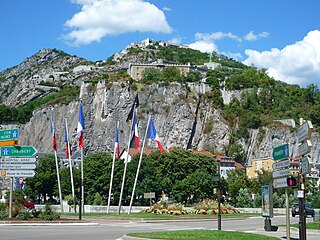
The Bastille is the name of a fortress culminating at 476 m (1,561ft) above sea level, located at the south end of the Chartreuse mountain range and overlooking the city of Grenoble, France. The Bastille, which also gives its name to the hill, is the main tourist site of the Grenoble area, with 600,000 visitors per year.

The Musée dauphinois, located in Grenoble (France), is dedicated to the ethnography, archaeology, history and society of the former province of the Dauphiné. Situated above the neighbourhood of Saint-Laurent in the listed historic monument of Sainte-Marie d’en-Haut, the Musée dauphinois is an accredited “Musée de France“ and takes part in the Long Night of Museums.

The Museum of Grenoble is a municipal museum of Fine Arts and antiquities in the city of Grenoble in the Isère region of France.

The Walls of Jerusalem surround the Old City of Jerusalem. In 1535, when Jerusalem was part of the Ottoman Empire, Sultan Suleiman the Magnificent ordered the ruined city walls to be rebuilt. The work took some four years, between 1537 and 1541. The walls are visible on most old maps of Jerusalem over the last 1,500 years.

Vertillum is a Gallo-Roman site in the modern commune of Vertault in the Côte-d'Or department of eastern France. It has been extensively excavated over the past century. Many of the objects found at the site are held in the nearby Musée du Pays Châtillonnais.

Grenoble Archaeological Museum is a museum located in Grenoble, France. It occupies the historic site of Saint-Laurent at the foot of the Bastille on the right bank of the Isère.

François Joseph Guiguet was a French painter.

The Musée de l'Ancien Évêché is a departmental museum located in Grenoble, France and dedicated to the Isère heritage through the history of its Bishop's palace. Inaugurated in 1998, it is settled in the former Bishop's palace, near Grenoble Cathedral. The museum gives access to the remains of an early Christian baptistry and to a section of the vestiges of the Gallo-Roman wall in the basement of the building.
The following is a timeline of the history of the city of Grenoble, France.

The Tower of Vesunna is the vestige of a Gallo-Roman fanum (temple) dedicated to Vesunna, a tutelary goddess of the Petrocorii. The sanctuary was built in the 1st or 2nd century. Vesunna was the Gallo-Roman name for Périgueux, in the Dordogne department, in the Nouvelle-Aquitaine region.

Place de Verdun is a public square in the French commune of Grenoble in the French department of Isère, in the Auvergne-Rhône-Alpes region.
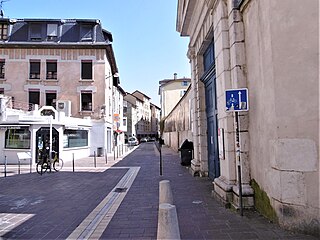
Rue Très-Cloîtres is a public road in the French commune of Grenoble.
